Yellow Diamonds Buying Guide
- Home /
- Diamond Buying Guides /
- Yellow Diamonds Buying Guide
While many of the basics of how to buy a diamond apply to all types of diamonds, they actually vary a bit among the different colors. And since yellow diamonds are the most commonly known color among natural colored diamonds (and for a good reason), we decided that preparing a guide on how to specifically buy them is a must.
In this guide we will try to cover everything from what are yellow diamonds, what is the meaning of their different intensities, explain about yellow diamond prices and how to become a smart shopper. For those that prefer seeing before reading - here is a quick video with the highlights taken from the guide:
- What are yellow diamonds?
- Are yellow diamonds rare?
- Yellow diamonds vs white diamonds
- Yellow diamonds prices
- Are yellow diamonds more expensive?
- Yellow diamonds colors
- Yellow diamonds color scale
Note that while there is a strong trend of buying yellow diamonds for investment purposes, this guide is not meant for that. This guide has all that is needed in order to buy a yellow diamond for what it was intended - making beautiful jewelry.
With that said, let's begin:
What Are Yellow Diamonds?
The diamond color scale used for white diamonds goes from D to Z. As the letter is closer to Z, it means that the diamond is less colorless and starts to be a bit yellowish in tone, a pale yellow shade. This degrades the diamond and their prices decrease as you get closer to Z.
However, at a certain point, if you "continue on the color scale", the color doesn't look as a faded yellow and instead becomes a beautiful yellow shade - this is the point when the price increases again and the diamond is considered a yellow diamond.
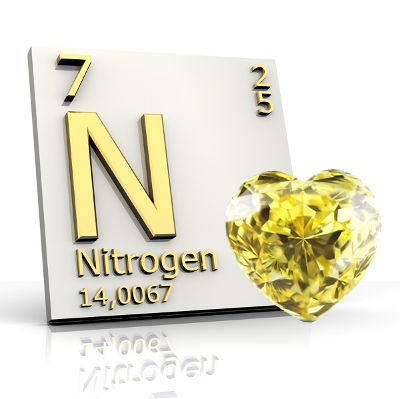
Yellow diamonds belong to the special family of natural fancy color diamonds. Regular diamonds that due to impurities found in them (a fluke of nature) change their color during their formation process - making them everything but regular.
The cause for each color is different, green diamonds get their color due to radiation, the cause for blue color is boron and yellow diamonds get their color due to the existence of nitrogen molecules which absorb blue light. This impurity is also what gives orange diamonds their color.
Are Yellow Diamonds Rare?
Natural colored diamonds are extremely rare. Only one out of approximately 10,000 carats is a natural colored diamond. Among the rainbow of colors you will find the romantic pinks and purples, the dazzling blue, the intriguing green, the energetic orange and off course the shiny and brilliant yellows.
Within the niche of color diamonds yellows are the most common. Estimations are that they make up to 60% of the colored diamonds. However, putting things in perspective, it means that approximately 1 out of 16,500 carats that are mined is a yellow diamond - so yes, yellow diamonds are rare.
Yellow Diamonds vs White Diamonds
Interestingly, a lot of times when a comparison is made between colorless white diamonds to fancy color diamonds the comparison is made with yellow diamonds.
The two main reasons is that yellow diamonds are probably the most commonly known diamond within the family of fancy diamonds and the other is that they are close to white diamonds in pricing.
Both of these make yellow diamonds one of the best alternatives to white diamonds when it comes to engagement rings. Adding a touch of fashion and personality to classic engagement rings.
But what’s left to compare and probably one of the most important aspects is their pricing…
Yellow Diamonds Prices
I wish there was a yellow diamonds price calculator or even a price chart but unfortunately there isn’t one (even though some attempts were made in the past).
Here are some example price points that will give you a baseline as for the prices of yellow diamonds compared to white diamonds. Please note that while we try to give you a lot of examples, no two diamonds are alike. So please avoid use this price table wisely. And as you go down the article you’ll get more tools to assess on your own the different diamonds that you encounter while browsing for a yellow diamond ring.
Yellow Diamonds Price Chart
| Diamond Color | 0.50ct Price | 1.00ct Price | 2.00ct Price | 3.00ct Price |
|---|---|---|---|---|
| Fancy Light Yellow Diamond | $750 - $1,000 | $2,500 - $4,000 | $5,500 - $8,000 | $12,500 - $17,500 |
| Fancy Yellow Diamond | $1,000 - $1,250 | $3,000 - $4,000 | $8,000 - $10,000 | $18,000 - $25,000 |
| Fancy Intense Yellow Diamond | $1,500 - $2,000 | $3,500 - $5,000 | $15,000 - $20,000 | $25,000 - $40,000 |
| Fancy Vivid Yellow Diamond | $2,000 - $3,000 | $8,500 - $12,500 | $30,000 - $40,000 | $55,000 - $75,000 |
| White - G Color | $1,000 | $4,500 | $15,000 | $40,000 |
So to conclude...
Are Yellow Diamonds More Expensive?
The chart above answers the question of are yellow diamonds cheaper than white diamonds or are they more expensive. Prices of a good quality white diamond, such as G color, is very similar to the price of a fancy yellow diamond. In the bigger and rarer sizes, the price of the white diamond is more similar to the one of the fancy intense yellow, rather than of the fancy yellow.
Take for example a 3 carat diamond - a 3 carat G color diamond would cost about $40,000 whereas a 3 carat fancy yellow diamond would cost "only" about $20,000 and a fancy intense $25,000-$40,000. And a 5 carat G color diamond is about $100,000 while a 5 carat fancy yellow is $40,000-$60,000 and a 5 carat fancy intense would go for $80,000-$120,000.
* Important note about the above prices - The white diamond prices refer to a round diamond and the yellow diamonds prices are of a cushion or radiant since round yellow diamonds are practically impossible to find.
The Different Colors of Yellow Diamonds
Yes, the title is not a mistake. Yellow diamonds are a family of colors on their own. Colored diamonds often don't come in a pure form but rather as a combination of colors.
When the GIA grades a colored diamond (Gemological Institute of America) it states the exact color description. This color description can be comprised of two and even three colors plus the intensity level.
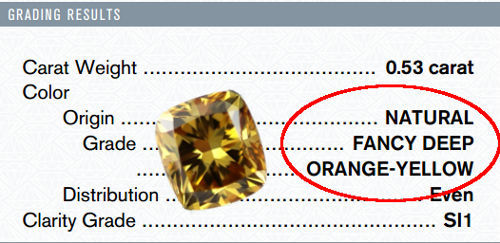 GIA certificate of a Fancy Deep Orange Yellow Diamond
GIA certificate of a Fancy Deep Orange Yellow DiamondThe most common color combinations found in yellow diamonds are: Brown Yellow, Green Yellow and Orange Yellow. The last color that is mentioned in the color description is considered the dominant one.
This means that if a diamond is graded as a green yellow diamond it is a diamond that is yellow and has a secondary tone of green in it while a yellow green diamond is a green diamond with a secondary tone of yellow. It is important to understand that between the two diamonds mentioned here there is a vast difference in appearance, in rarity and in pricing.
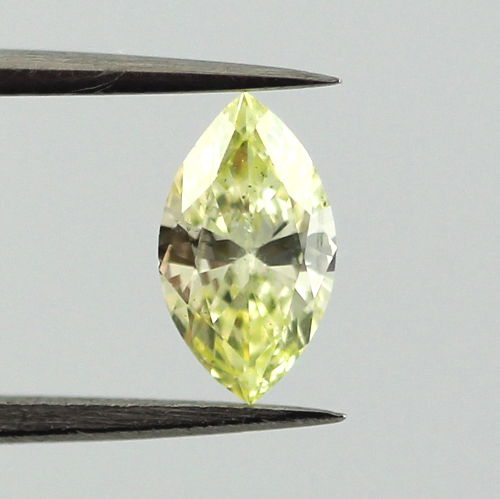
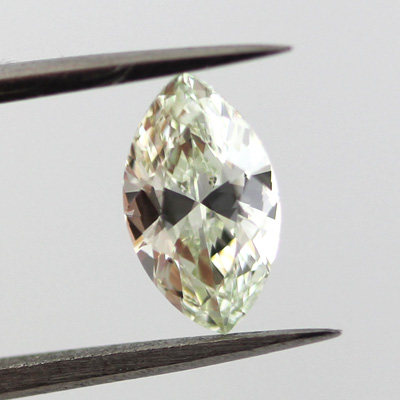
Fancy Green Yellow Diamond (left) VS Fancy Yellow Green Diamond (right)
Most people looking for yellow diamonds do not understand or look for diamonds with secondary hues. Because color combinations in colored diamonds is a very complex matter, from this point on, we will be talking and explaining mainly about pure yellow diamonds. Diamonds that are often referred as canary diamonds or canary yellows.
Yellow Diamond Color Scale
When grading colored diamonds, beside determining the color or color combination of the diamond, the color is also graded for intensity. Same goes for grading yellow diamonds.
There are yellow diamonds with a very strong color and there are yellow diamonds that the yellow shade is quite weak - yellowish or even just a yellow tint. For that purpose an intensity color scale was invented.
The intensity scale of colored diamonds goes as follows:
Faint, Very Light, Light, Fancy Light, Fancy, Fancy Dark, Fancy Deep, Fancy Intense and the fancy vivid.
Several colored diamonds colors don't have all levels on the scale. In our case, there are no Faint, Very Light and Light yellow diamonds - these are referred as cape diamonds, diamonds from the lower end of the D-Z color scale (U-V and Y-Z) which appear somewhat yellowish. The name "Cape Diamonds" is because these diamonds originated from Cape Province in South Africa.
The first level in which a yellow diamond is considered a fancy diamond is with Fancy Light Yellow. There is also no such thing as a pure fancy dark yellow diamond but there is in combination with brown etc.
Here is the actual yellow diamonds color scale in order of rarity and pricing:
Faint, Very Light, Light, Fancy Light, Fancy, Fancy Dark (pure yellow), Fancy Deep, Fancy Intense and the fancy vivid.
Many people consider cape diamonds - U-V and Y-Z diamonds (colorless with yellowish tint) as replacements to the light yellow diamonds.
Below you can see examples of how yellow diamonds look in the different intensities:
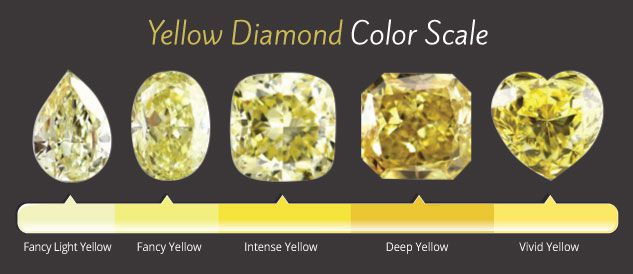 Yellow Diamond Color Scale
Yellow Diamond Color ScaleAs can be imagined just by looking at the pictures, the vivid yellows are extremely rare and sought after and are priced accordingly.
Now that we've established the basics about natural yellow diamonds, we will move towards the grading, pricing and buying tips.
How the 4C's affect Yellow Diamond Prices?
Determining and evaluating the price of a diamond, any diamond, is extremely difficult. In white colorless diamonds, you lean on a price list (which fluctuates a lot) and add / subtract to the price all other attributes that the specific diamond possesses (hint: not only the 4cs of diamonds).
However, when it comes to evaluating the price of a colored diamond, it requires extreme expertise. The reason is quite understandable . As mentioned on top, there are hundreds of color combinations, and the price differences between them are vast. The existence of a brownish tint in a yellow diamond will reduce its value dramatically whereas green or orange will increase it.
When grading yellow diamonds, the first thing we will look at (as with all colored diamonds) is the color. While in colorless diamonds some might say that clarity and color are equivalent in the way they influence the price and value, in colored diamonds (including yellow diamonds) the pricing begins with the color. It is by far the most important attribute and we will start with it.
Yellow Diamond Color and its Effect on Pricing
The price of commodities is dictated by supply and demand - basic rules of economy. BUT… in yellow diamonds (and actually most colored diamonds) the problem is that the most desired diamonds (i.e. demand) are also the rarest diamonds (i.e. supply). The result is that the price increase between the color scale levels are EXTREMELY high (percentage wise). We could say that is human nature - people wanting what they can't have, but from the looks of it, it is because of the looks of it…
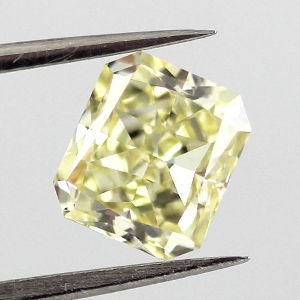
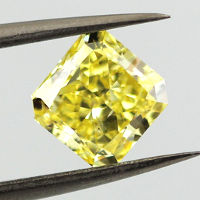
Fancy Light ($3,500) VS Fancy Vivid ($12,500)
Which would you prefer?
Therefore, the pricing (as can be expected) is in compliance with the intensity level - the stronger the yellow color, the price goes up. Let's get into details:
With all factors the same (and speaking on Natural Yellow Diamonds), the cheapest yellow diamonds actually make a very interesting buy - fancy light yellow diamonds. These are still relatively cheap yellow diamonds and priced equivalent to I color white diamonds (nothing is cheap about diamonds but relatively speaking). However, while an I color diamond would look pale yellow and is often not recommended, a fancy light yellow mounted in yellow gold (or white gold with a yellow gold basket and crown) makes a good value for money diamond priced at $3,500 per a 1 carat diamond.
SEE ALSO: Why buy faint and light colored diamonds? (opens in new window)
Fancy Yellow Diamonds (one step above fancy light) are the most commonly known of yellow diamonds. They have a very clear yellow hue and are priced in average similar to a good quality colorless diamond (F-G colors) - in the range of $4,500-$5,000.
Fancy Deep yellow diamonds have a very unique and distinguished color not favored by all. Here, based on our experience, rarity has an effect on pricing more than the demand. It is considered a worm color and often has a secondary hue of brown (which reduces the price). Pure deep yellows are quite hard to find and their prices can vary dramatically - in good size and clarity can be priced more than intense but only because of supply and not demand.
Fancy Intense Yellow Diamonds are probably the most sought after yellows. Their yellow shade is extremely pure and clear which has earned them the nickname / synonym of Canary Diamonds.
Price wise they are 25%-50% more than fancy yellows which places them more expensive than white counterparts. The price for a 1 carat good quality Intense Yellow is currently in the range of $6,500 - $8,000.
Last but definitely not least are fancy vivid yellow diamonds. These gems are extremely rare and shine like very few diamonds do. The GIA doesn't specify degrees within the various intensities. While in fancy the difference between a "good" fancy and a "bad" fancy is negligible, in vivids this difference causes a high deviation in prices and they can range $12,000-$18,000 for an average quality 1 carat vivid yellow diamond. This makes them twice the price of an Intense Yellow and 3 times the price of a Fancy Yellow.
There is a small group / type of vivid yellow diamonds that is valued even more. These are vivid yellow diamonds that come from the Zimmy mine in Africa. Their yellow color is simply astounding and they are priced $20,000-$30,000 per carat.
If we compare prices of yellow diamonds with white diamonds then fancy yellow diamonds are in a similar price level to that of white diamonds.
Interestingly, back in 2005 the GIA has conducted an extremely thorough study on yellow diamonds. Their study showed that during 2003 46% of the yellow diamonds they have graded were Fancy, 21% were fancy light, 24% were intense, 3% were deep and dark and 6% were vivid.
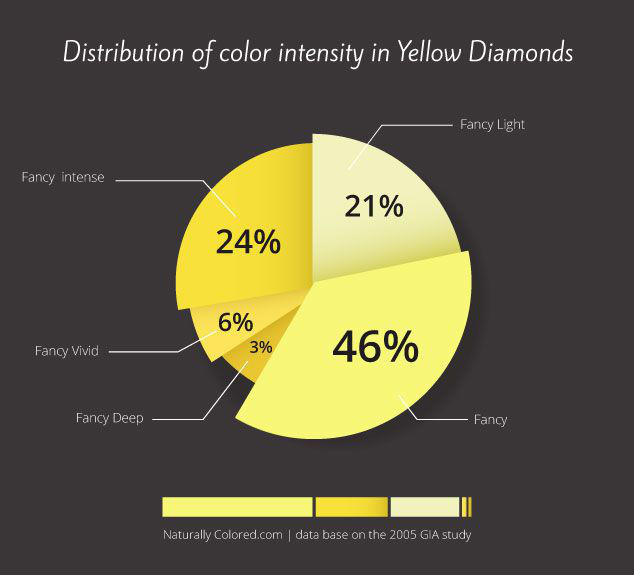
The (big) problem with this study as we see it is that it (obviously) measures ONLY diamonds the GIA graded and not all diamonds. This means that lower quality diamonds, cheaper yellow diamonds, whether due to lower clarity, smaller size or weaker lighter color might have not been sent at the time for grading and therefore the results were value biased. No dealer would have bothered grading (costs $160 dollar and more) a half a carat fancy light yellow but many did grade half a carat intense or vivid.
How the appearance of a Secondary color affects the value of Yellow Diamonds
We mentioned that the color aspect is the most important when it comes to pricing of colored diamonds. But color does not mean only color intensity, color also means actual color.
The color aspect can be divided into two areas - The first is the color strength, color intensity (as seen above in the yellow diamond color scale). The second is the existence or nonexistence of secondary colors and which colors…
When you refer to yellow diamonds you usually mean pure yellow diamonds. But yellow diamonds (as other colored diamonds) are often found with secondary colors. Color combinations such as orange yellow, green yellow and brown yellow are very common.
It is extremely difficult to compare prices of impure yellow diamonds. But generally speaking, if the secondary color is one of a more expensive colored diamond then the price goes up - green yellow and orange yellow diamonds are more expensive than pure yellows. Needless to say that if the secondary color is of a more common diamond then the price goes down - just as in the case of brown yellow diamonds. Meaning diamonds graded as brownish yellow or brown yellow diamonds are the cheapest forms of yellow diamonds. Color intensity still plays its role – intense orange yellow is more expensive than fancy orange yellow.
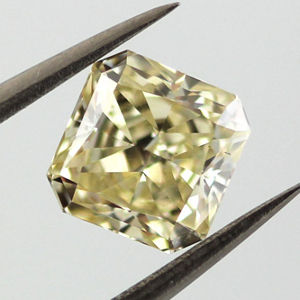

Fancy Brownish Yellow Diamond VS Fancy Light Yellow Diamond
$2,500 vs $3,500 even though the yellow is light
Cut, Clarity and Carat
The remaining 3 C's have a similar effect like with white diamonds - we will cover the basics.
Carat
Carat weight has tremendous effect on pricing. Diamonds are priced per carat and the price goes up exponentially along with the weight. The price per carat of a 1 carat yellow diamond will be much higher than the price per carat of half a carat diamond (meaning that 2*0.50ct diamonds cost less than 1*1ct diamond). Multiply it by the actual weight and the difference is amazing.
Savings Tip 1:
The classic weight levels are accompanied with a price bounce. The price per carat (ppc) of a 0.50 carat yellow diamond is much higher than ppc of a 0.45 carat, a 1 carat yellow diamond costs much more than 0.90 carat and the price of a 2 carat yellow is a lot more than a 1.85 carat similar diamond. This is true even though you might not even notice the difference by looking at the diamond. The result is that a 1 carat diamond can easily cost 30% more than a 0.90 carat yellow diamond.
Savings Tip 2:
Carat weight does NOT mean size, as its name it means weight! A 150 pounds person doesn't have to be taller or wider than a 140 person - just heavier. You should look at the MM measurements of the diamond and not only the carat weight.
Clarity
The diamond clarity chart goes as follows: FL, IF, VVS1, VVS2, VS1, VS2, SI1, SI2, I1, I2. FL is the highest value (Flawless) and I2 is the lowest (Included level 2). There is no much difference in pricing between a vs1 and a vs2 and same between VVS1 and VVS2. However, if we would divide the clarity levels into groups, there you would see a jump in pricing between groups. The groups would be FL and IF, VVS1 and VVS2, VS1 and VS2, SI1 and SI2, I1 and I2. There is a relatively big difference between these "groups" of clarity. An interesting fact about the clarity in yellow diamonds: Yellow diamonds are known to be found in nature with relatively high clarity grading. This means that finding yellow diamonds with VS clarity and higher is relatively an easy task.
Savings Tip 3:
Keep in mind that SI1 diamonds and even most of SI2 diamonds are supposed to be "eye clean" - with inclusions that are invisible to the naked eye, invisible without a magnifying glass. This is why when approaching to buy a yellow diamond with a limited budget we recommend our customers to go for si1 diamonds - they offer very good value for pricing, good value for money. Alternatively, you can buy a bigger si1 yellow diamond than a vvs1 yellow diamond - which criteria would you notice in plain site?
Cut
Unlike most people think, cut does not mean shape. Cut means the quality, the make of the diamond in considering the shape that it was cut into. It also effects on how the diamond would look in proportions to its weight (as discussed in Savings Tip #2).
It is commonly said that colored diamonds are cut to maximize the color but the fact is that they are cut to maximize their value. Usually, it means the same thing since strong yellow diamond is worth more than a tinted yellow. However, if the cutter needs to drop below 1.00 to 0.98 to maximize the color, most chances he won't. Even if it means that it will be less symmetric etc. A bad cut will reduce the price and an excellent cut might get a premium. In the middle it is not that different.
Savings Tip 4:
don't aim or limit yourself for excellent cut and do stay away from bad ones (such as fair symmetry and poor polish). Very good polish and symmetry is quite excellent. Even good might do the trick - just look at it and make sure that it looks good, not crooked.
Shape
This is a good place to discuss about the shape of the diamond which even though not in the 4 Cs does have an effect on the price.
You will hardly see a round yellow diamond since it is harder for the color to be seen in round diamonds. What would be a round fancy yellow diamond would probably get a color grading of intense if it was cut into a different shape such as a cushion or a radiant. Cushions, Radiants and Ovals are more or less the same price levels. Marquise cut diamonds are priced lower and rounds are MUCH higher.
Savings Tip 5:
If you truly want a round yellow diamond but cannot find or afford one, you can consider an oval or a cushion cut with a low length to width ratio (a squarish cushion cut or a rounded fat oval). These are easier to obtain and would cost much less. Same concept about princess cut yellow - when mounted, a squarish radiant cut would look practically the same.
The Fifth C - Certificate
The purpose of the gemological certificate is to objectively ensure two things -
- The diamond's color is natural
- What are the attributes of the diamond (including the 4Cs above and few more).
The most commonly known institutes are:
- GIA - Gemological Institute of America
- IGI - International Gemological Institute
- EGL - European Gemological Laboratory
While we trust all known gemological institutes to verify if a yellow diamond is yellow due to natural reasons or as a cause of treatment (man-made), for the purpose of identifying the actual attributes and especially the exact color description - we trust only the GIA.
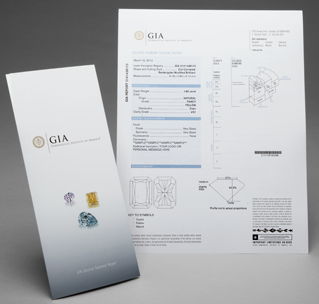
The element of accuracy can be seen quite nicely on websites that offer both GIA certified diamonds and IGI certified diamonds. Usually, an IGI pink diamond would cost much less than a GIA pink diamond… Same goes for an Intense Yellow graded by the IGI that will cost closer to a Fancy Yellow by the GIA.
There are vast differences in prices between diamonds with minor changes in colors. As discussed, a vivid yellow costs about twice the price of an intense and an intense can easily cost 50% more than fancy. Wouldn't you want to know exactly which diamond you have (or about to buy)?
The price of a full GIA certificate for colored diamonds costs approximately $160 (and more – depends on the size of the diamond). This will probably be the best money you have ever spent.
How Fluorescence Affects the Price of a Yellow Diamond
One of the many attributes we consider when we grade and evaluate a diamond that are outside the 4Cs is fluorescence.
Diamond Education
Most people know that fluorescence is considered a flaw and reduces diamond prices. This is true in white diamonds but not exactly true in colored diamonds with the exception of… yellow diamonds. Unlike in other colored diamonds, fluorescence does reduce the value of yellow diamonds, even dramatically.
The reason is not exactly known and understood in my opinion but there is some sense, some logic to it. Firstly, pure things (such as diamonds with no fluorescence) are rarer and therefore cost more. Secondly, fluorescence in yellow diamonds is usually blue. If you look at a yellow diamond with strong blue fluorescence it does seem to affect the color (not always).
But this is the case with strong blue fluorescence grading, what about faint blue? No one will know the difference looking at the diamond unless looking under a UV lamp yet the price is reduced. Since people are afraid for a change in the pure yellow color, the price is dramatically reduced if it is medium or strong, some might say these diamonds are a taboo.
To conclude, Faint fluorescence reduces the price a bit (up to 10%), Medium or Strong reduces a lot (even 15%-30%). It is up to you to decide if it is worth it or not. Take for example the following intense yellow diamond that was sold for $2,000 instead of $3,000… simply because it was graded with strong blue fluorescence.
Would you rather have a fancy yellow with no fluorescence or a fancy intense with fluorescence?
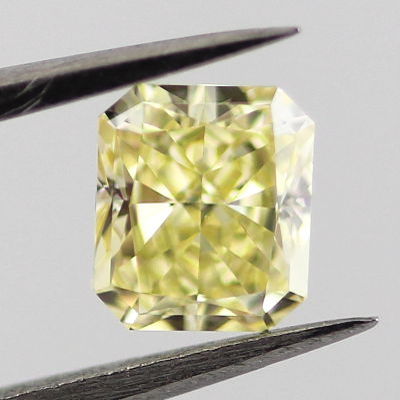
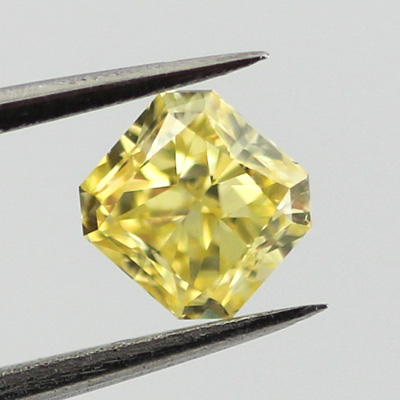
Fancy Yellow Diamond & Fancy Intense Yellow Diamond with Strong fluorescence
Both $2,000
